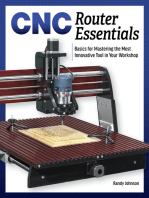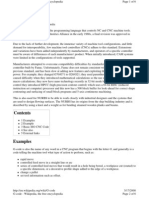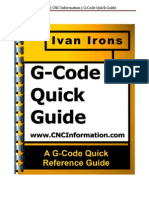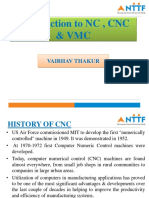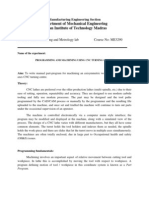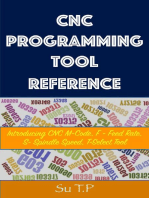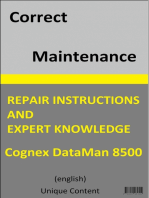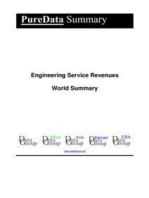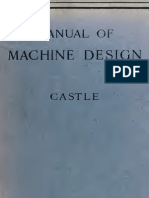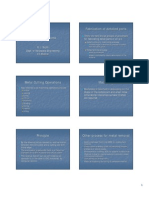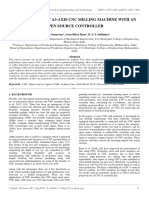G Code
Uploaded by
ROHAN DESAIG Code
Uploaded by
ROHAN DESAIG-code
From Wikipedia, the free encyclopedia
Jump to: navigation, search This article is about the machine tool programming language. For the video recorder programming system, see Video recorder scheduling code. G-Code, or preparatory code or function, are functions in the Numerical control programming language. The G-codes are the codes that position the tool and do the actual work, as opposed to M-codes, that manages the machine; T for tool-related codes. S and F are toolSpeed and tool-Feed, and finally D-codes for tool compensation. The programming language of Numerical Control (NC) is sometimes informally called G-code. But in actuality, G-codes are only a part of the NC-programming language that controls NC and CNC machine tools. The term Numerical Control was coined at the MIT Servomechanisms Laboratory, and several versions of NC were and are still developed independently by CNC-machine manufacturers. The main standardized version used in the United States was settled by the Electronic Industries Alliance in the early 1960s. A final revision was approved in February 1980 as RS274D. In Europe, the standard DIN 66025 / ISO 6983 is often used instead. Due to the lack of further development, the immense variety of machine tool configurations, and little demand for interoperability, few machine tool controllers (CNCs) adhere to this standard. Extensions and variations have been added independently by manufacturers, and operators of a specific controller must be aware of differences of each manufacturers' product. When initially introduced, CAM systems were limited in the configurations of tools supported. Today, the main manufacturers of CNC control systems are GE Fanuc Automation (joint venture of General Electric and Fanuc), Siemens, Mitsubishi, and Heidenhain, but there still exist many smaller and/or older controller systems. Some CNC machine manufacturers attempted to overcome compatibility difficulties by standardizing on a machine tool controller built by Fanuc. Unfortunately, Fanuc does not remain consistent with RS-274 or its own previous versions, and has been slow at adding new features, as well as exploiting increases in computing power. For example, they changed G70/G71 to G20/G21; they used parentheses
for comments which caused difficulty when they introduced mathematical calculations so they use square parentheses for macro calculations; they now have nano technology recently in 32-bit mode but in the Fanuc 15MB control they introduced HPCC (high-precision contour control) which uses a 64-bit RISC processor and this now has a 500 block buffer for look-ahead for correct shape contouring and surfacing of small block programs and 5-axis continuous machining. This is also used for NURBS to be able to work closely with industrial designers and the systems that are used to design flowing surfaces. The NURBS has its origins from the ship building industry and is described by using a knot and a weight as for bending steamed wooden planks and beams.
Contents
[hide]
1 Common Codes 2 Example Program 3 See also 4 External links
[edit] Common Codes
G-codes are also called preparatory codes, and are any word in a CNC program that begins with the letter 'G'. Generally it is a code telling the machine tool what type of action to perform, such as:
rapid move controlled feed move in a straight line or arc series of controlled feed moves that would result in a hole being bored, a workpiece cut (routed) to a specific dimension, or a decorative profile shape added to the edge of a workpiece. change a pallet set tool information such as offset.
There are other codes; the type codes can be thought of like registers in a computer X absolute position Y absolute position Z absolute position
A position (rotary around X) B position (rotary around Y) C position (rotary around Z) U Relative axis parallel to X V Relative axis parallel to Y W Relative axis parallel to Z M code (another "action" register or Machine code(*)) (otherwise referred to as a "Miscellaneous" function") F feed rate S spindle speed N line number R Arc radius or optional word passed to a subprogram/canned cycle P Dwell time or optional word passed to a subprogram/canned cycle T Tool selection I Arc data X axis J Arc data Y axis. K Arc data Z axis, or optional word passed to a subprogram/canned cycle D Cutter diameter/radius offset H Tool length offset (*) M codes control the overall machine, causing it to stop, start, turn on coolant, etc., whereas other codes pertain to the path traversed by cutting tools. Different machine tools may use the same code to perform different functions; even machines that use the same CNC control.
Partial list of M-Codes M00=Program Stop (non-optional) M01=Optional Stop, machine will only stop if operator selects this option M02=End of Program M03=Spindle on (CW rotation) M04=Spindle on (CCW rotation) M05=Spindle Stop M06=Tool Change M07=Coolant on (flood) M08=Coolant on (mist) M09=Coolant off M10=Pallet clamp on M11=Pallet clamp off M30=End of program/rewind tape (may still be required for older CNC machines)
Common FANUC G Codes for Mill
Code G00 G01 G02 G03 G04 G05.1 Q1. G05 P10000 G07 G09 G10/G11 G12 G13 G17 Rapid positioning Linear interpolation
Description
CW circular interpolation CCW circular interpolation Dwell Ai Nano contour control
HPCC
Imaginary axis designation Exact stop check Programmable Data input/Data write cancel CW Circle Cutting CCW Circle Cutting X-Y plane selection
G18 G19 G20 G21 G28 G30
X-Z plane selection Y-Z plane selection Programming in inches Programming in mm Return to home position 2nd reference point return Skip function (used for probes and tool length measurement systems) Constant pitch threading Variable pitch threading Tool radius compensation off Tool radius compensation left Tool radius compensation right Tool offset compensation negative Tool offset compensation positive
G31
G33 G34 G40 G41 G42 G43 G44
G45 G46 G47 G48 G49 G50 G53
Axis offset single increase Axis offset single decrease Axis offset double increase Axis offset double decrease Tool offset compensation cancel Define the maximum spindle speed Machine coordinate system
G54 to G59 Work coordinate systems G54.1 P1 to Extended work coordinate systems P48 G73 G74 G76 G80 G81 High speed drilling canned cycle Left hand tapping canned cycle Fine boring canned cycle Cancel canned cycle Simple drilling cycle
G82 G83 G84 G84.2 G90 G91 G92
Drilling cycle with dwell Peck drilling cycle Tapping cycle Direct right hand tapping canned cycle Absolute programming (type B and C systems) Incremental programming (type B and C systems) Programming of absolute zero point Inch per minute/Inch per revolution feed (type A system) Note: Some CNCs use the SI unit system Constant surface speed Constant Spindle speed Return to Initial Z plane/R plane in canned cycle
G94/G95
G96 G97 G98/G99
A standardized version of G-code known as BCL is used, but only on very few machines. G-code files may be generated by CAM software. Those applications typically use translators called post-processors to output code optimized for a particular machine type or family. Post-processors are often user-editable to enable further customization, if necessary. Gcode is also output by specialized CAD systems used to design printed circuit boards. Such software must be customized for each type of machine tool that it will be used to program. Some G-code is written by
hand for volume production jobs. In this environment, the inherent inefficiency of CAM-generated G-code is unacceptable. Some CNC machines use "conversational" programming, which is a wizard-like programming mode that either hides G-code or completely bypasses the use of G-code. Some popular examples are Southwestern Industries' ProtoTRAK, Mazak's Mazatrol, Hurco's Ultimax and Mori Seiki's CAPS conversational software.
[edit] Example Program
This is a generic program that demonstrates the use of G-Code to turn a 1" diameter X 1" long part. Assume that a bar of material is in the machine and that the bar is slightly oversized in length and diameter and that the bar protrudes by more than 1" from the face of the chuck. (Caution: This is generic, it might not work on any real machine! Pay particular attention to point 5 below.)
Tool Path for program Sample Lin e
Code
Description
N01 M216 G00 X20 Z20
Turn on load monitor Rapid move away from the part, to ensure the starting position of the tool
N02
N03 G50 S2000 Set Maximum spindle speed N04 M01 N05 T0303 M6 Optional stop Select tool #3 from the carousel, use tool offset values located in line 3 of the program table, index
the turret to select new tool G96 S854 N06 M42 M03 M08 G00 X1.1 Z1.1 G01 Z1.0 F.05
Variable speed cutting, 854 ft/min, High spindle gear, Start spindle CW rotation, Turn the mist coolant on
N07
Rapid feed to a point 0.1" from the end of the bar and 0.05" from the side Feed in horizontally until the tool is standing 1" from the datum Feed down until the tool is on center - Face the end of the bar Rapid feed 0.1" away from the end of the bar Rapid feed up until the tool is standing at the finished OD Feed in horizontally cutting the bar to 1" diameter all the way to the datum Stop the spindle, Turn off the coolant Home X axis in the machine coordinate system, then home all other axes Turn the load monitor off Program stop, pallet change if applicable, rewind to beginning of the program
N08
N09 X0.0
N10 G00 Z1.1
N11 X1.0
N12
G01 Z0.0 F.05
N13 M05 M09
N14 G28 G91 X0
N15 M215
N16 M30
Several points to note: 1. There is room for some programming style, even in this short program. The grouping of codes in line N06 could have been put on multiple lines. Doing so may have made it easier to follow program execution. 2. Many codes are "Modal" meaning that they stay in effect until they are cancelled or replaced by a contradictory code. For example, once variable speed cutting had been selected (G96), it stayed in effect until the end of the program. In operation, the spindle speed would increase as the tool neared the center of the work in order to maintain a constant cutting speed. Similarly, once rapid feed was selected (G00) all tool movements would be rapid until a feed rate code (G01, G02, G03) was selected. 3. It is common practice to use a load monitor with CNC machinery. The load monitor will stop the machine if the spindle or feed loads exceed a preset value that is set during the set-up operation. The job of the load monitor is to prevent machine damage in the event of tool breakage or a programming mistake. On small or hobby machines, it can warn of a tool that is becoming dull and needs to be replaced or sharpened. 4. It is common practice to bring the tool in rapidly to a "safe" point that is close to the part - in this case 0.1" away - and then start feeding the tool. How close that "safe" distance is, depends on the skill of the programmer and maximum material condition for the raw stock. 5. If the program is wrong, there is a high probability that the machine will crash, or ram the tool into the part under high power. This can be costly, especially in newer machining centers. It is possible to intersperse the program with optional stops (M01 code) which allow the program to be run piecemeal for testing purposes. The optional stops remain in the program but they are skipped during the normal running of the machine. Thankfully, most CAD/CAM software ships with CNC simulators that will display the movement of the tool as the program executes. Many modern CNC machines also allow programmers to execute the program in a simulation mode and observe the operating parameters of the machine at a particular execution point. This enables programmers to discover semantic errors (as opposed to syntax errors) before losing material or tools to an incorrect program. Depending on the size of the part, wax blocks may be used for testing purposes as well. 6. For pedagogical purposes, line numbers have been included in the program above. They are usually not necessary for operation of a machine, so they are seldom used in industry. However, if branching or looping statements are used in the code, then line
numbers may well be included as the target of those statements (e.g. GOTO N99).
You might also like
- CNC Router Essentials: The Basics for Mastering the Most Innovative Tool in Your WorkshopFrom EverandCNC Router Essentials: The Basics for Mastering the Most Innovative Tool in Your Workshop5/5 (3)
- Assembly & User Guide: By: Henry Arnold Jonathan KNo ratings yetAssembly & User Guide: By: Henry Arnold Jonathan K84 pages
- 01-An Approach To Improved CNC Machining Using Vision-Based SystemNo ratings yet01-An Approach To Improved CNC Machining Using Vision-Based System11 pages
- G-Code - Wikipedia, The Free EncyclopediaNo ratings yetG-Code - Wikipedia, The Free Encyclopedia6 pages
- G-Code - Wikipedia, The Free EncyclopediaNo ratings yetG-Code - Wikipedia, The Free Encyclopedia21 pages
- Dr. V.Chittaranjan Das Professor, Department of Mechanical Engineering, GunturNo ratings yetDr. V.Chittaranjan Das Professor, Department of Mechanical Engineering, Guntur23 pages
- Chapter 4 - Part Programming-Manual ProgrammingNo ratings yetChapter 4 - Part Programming-Manual Programming63 pages
- EN - Complete Sinumerik Operate Milling - v26100% (1)EN - Complete Sinumerik Operate Milling - v26690 pages
- What Is A Machine?: Conventional MachinesNo ratings yetWhat Is A Machine?: Conventional Machines48 pages
- Unit III CNC Part Programming and Recent Trends (L_250222_145306No ratings yetUnit III CNC Part Programming and Recent Trends (L_250222_1453063 pages
- List of G Codes: SR - NO. Code Function 1. 2. 3. 4100% (1)List of G Codes: SR - NO. Code Function 1. 2. 3. 428 pages
- CAM Lab Manual Expereiment - 10-13 - CAMNo ratings yetCAM Lab Manual Expereiment - 10-13 - CAM9 pages
- Computer Numerical Control Machine: By-Er - Ved PrakashNo ratings yetComputer Numerical Control Machine: By-Er - Ved Prakash28 pages
- Computer Numerical Control Programming Basics: DefinitionsNo ratings yetComputer Numerical Control Programming Basics: Definitions8 pages
- Engineering Service Revenues World Summary: Market Values & Financials by CountryFrom EverandEngineering Service Revenues World Summary: Market Values & Financials by CountryNo ratings yet
- Industrial Machinery World Summary: Market Values & Financials by CountryFrom EverandIndustrial Machinery World Summary: Market Values & Financials by CountryNo ratings yet
- Preliminary Specifications: Programmed Data Processor Model Three (PDP-3) October, 1960From EverandPreliminary Specifications: Programmed Data Processor Model Three (PDP-3) October, 1960No ratings yet
- Joint Photographic Experts Group: Unlocking the Power of Visual Data with the JPEG StandardFrom EverandJoint Photographic Experts Group: Unlocking the Power of Visual Data with the JPEG StandardNo ratings yet
- Uncertainty and Dimensional Calibration32 PDFNo ratings yetUncertainty and Dimensional Calibration32 PDF30 pages
- Design of Tabletop CNC Machine With Variable User InterfaceNo ratings yetDesign of Tabletop CNC Machine With Variable User Interface1 page
- A User's Guide To Installation, Configuration and OperationNo ratings yetA User's Guide To Installation, Configuration and Operation160 pages
- Sinumerik G63 Tapping With Floating TapholderNo ratings yetSinumerik G63 Tapping With Floating Tapholder27 pages
- Advanced Manufacturing Technology." University QuestionsNo ratings yetAdvanced Manufacturing Technology." University Questions10 pages
- Gcode Simulator Settings For The Vericut Interface (PDFDrive)No ratings yetGcode Simulator Settings For The Vericut Interface (PDFDrive)39 pages
- Mastercam2020 MultiaxisAdvanced TrainingTutorial SAMPLENo ratings yetMastercam2020 MultiaxisAdvanced TrainingTutorial SAMPLE43 pages
- Drufelcnc Nvсm5 V2.1 5 Axis (Novusun) Installation ManualNo ratings yetDrufelcnc Nvсm5 V2.1 5 Axis (Novusun) Installation Manual60 pages
- CNC Router Essentials: The Basics for Mastering the Most Innovative Tool in Your WorkshopFrom EverandCNC Router Essentials: The Basics for Mastering the Most Innovative Tool in Your Workshop
- Assembly & User Guide: By: Henry Arnold Jonathan KAssembly & User Guide: By: Henry Arnold Jonathan K
- 01-An Approach To Improved CNC Machining Using Vision-Based System01-An Approach To Improved CNC Machining Using Vision-Based System
- Dr. V.Chittaranjan Das Professor, Department of Mechanical Engineering, GunturDr. V.Chittaranjan Das Professor, Department of Mechanical Engineering, Guntur
- Unit III CNC Part Programming and Recent Trends (L_250222_145306Unit III CNC Part Programming and Recent Trends (L_250222_145306
- List of G Codes: SR - NO. Code Function 1. 2. 3. 4List of G Codes: SR - NO. Code Function 1. 2. 3. 4
- Computer Numerical Control Machine: By-Er - Ved PrakashComputer Numerical Control Machine: By-Er - Ved Prakash
- Computer Numerical Control Programming Basics: DefinitionsComputer Numerical Control Programming Basics: Definitions
- Computer Numerical Control Programming Tool ReferenceFrom EverandComputer Numerical Control Programming Tool Reference
- Engineering Service Revenues World Summary: Market Values & Financials by CountryFrom EverandEngineering Service Revenues World Summary: Market Values & Financials by Country
- Practical Field Robotics: A Systems ApproachFrom EverandPractical Field Robotics: A Systems Approach
- Industrial Machinery World Summary: Market Values & Financials by CountryFrom EverandIndustrial Machinery World Summary: Market Values & Financials by Country
- Preliminary Specifications: Programmed Data Processor Model Three (PDP-3) October, 1960From EverandPreliminary Specifications: Programmed Data Processor Model Three (PDP-3) October, 1960
- Joint Photographic Experts Group: Unlocking the Power of Visual Data with the JPEG StandardFrom EverandJoint Photographic Experts Group: Unlocking the Power of Visual Data with the JPEG Standard
- Design of Tabletop CNC Machine With Variable User InterfaceDesign of Tabletop CNC Machine With Variable User Interface
- A User's Guide To Installation, Configuration and OperationA User's Guide To Installation, Configuration and Operation
- Advanced Manufacturing Technology." University QuestionsAdvanced Manufacturing Technology." University Questions
- Gcode Simulator Settings For The Vericut Interface (PDFDrive)Gcode Simulator Settings For The Vericut Interface (PDFDrive)
- Mastercam2020 MultiaxisAdvanced TrainingTutorial SAMPLEMastercam2020 MultiaxisAdvanced TrainingTutorial SAMPLE
- Drufelcnc Nvсm5 V2.1 5 Axis (Novusun) Installation ManualDrufelcnc Nvсm5 V2.1 5 Axis (Novusun) Installation Manual

